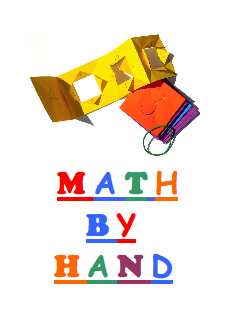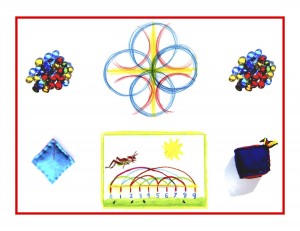
Day 137
For one year, 365 days, this blog will address the Common Core Standards from the perspective of creating an alternate, ambient learning environment for math. Ambient is defined as “existing or present on all sides, an all-encompassing atmosphere.” And ambient music is defined as: “Quiet and relaxing with melodies that repeat many times.
Why ambient? A math teaching style that’s whole and all encompassing, with themes that repeat many times through the years, is most likely to be effective and successful. Today’s post will feature the next Grade 2 Common Core Math Standard listed in blue, followed by its ambient counterpart as practiced by Waldorf Education and Math By Hand.
Number and Operations in Base Ten 2.NBT
Use place value understanding and properties of operations to add and subtract.
6. Add up to four two-digit numbers using strategies based on place value and properties of operations.
In the Math By Hand system, after place value is learned in a very concrete way using large, color-coded columns with manipulatives, confidence levels are high and allow much greater than four two-digit numbers to be computed. Long columns of three- and four-digit numbers are added, three- and four-digit numbers are subtracted, three- and four- digit numbers are multiplied by the numbers 2-12, and short division is computed with three- and four- digit numbers divided by the numbers 2-12. See below for practice suggestions taken from the Math By Hand Grade 2 binder.
Knowledge ensues in an environment dedicated to imaginative, creative knowing, where student and teacher alike surrender to the ensuing of knowledge as a worthy goal. Tune in tomorrow for more Common Core, and its ambient, Waldorf/Math By Hand counterpart.
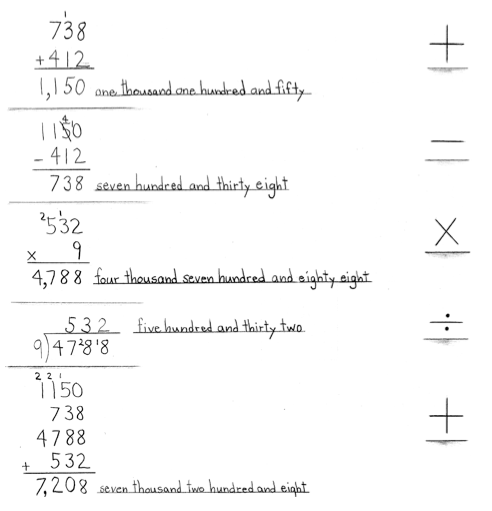
Tags:
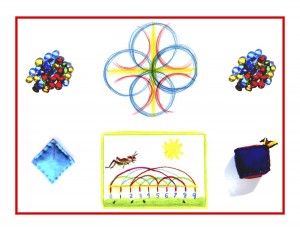
Day 136
For one year, 365 days, this blog will address the Common Core Standards from the perspective of creating an alternate, ambient learning environment for math. Ambient is defined as “existing or present on all sides, an all-encompassing atmosphere.” And ambient music is defined as: “Quiet and relaxing with melodies that repeat many times.
Why ambient? A math teaching style that’s whole and all encompassing, with themes that repeat many times through the years, is most likely to be effective and successful. Today’s post will feature the next Grade 2 Common Core Math Standard listed in blue, followed by its ambient counterpart as practiced by Waldorf Education and Math By Hand.
Number and Operations in Base Ten 2.NBT
Use place value understanding and properties of operations to add and subtract.
5. Fluently add and subtract within 100 using strategies based on place value, properties of operations, and/or the relationship between addition and subtraction.
The Grade 2 year begins with a review of computing in all 4 processes with a horizontal format. After switching to a vertical format, two- and three-digit numbers are computed with no regrouping, keeping multiplication and division short (the long forms of both will be introduced in Grade 3). Fluency in all 4 processes is attained up to several hundreds.
Math By Hand uses large, colorful, hands-on materials to teach place value (see the image below). Color coded columns for both the floor and desktop use large number cards and value-coded beans (this is also translated to coins, using pennies, dimes, and silver dollars). Carrying and borrowing in all 4 processes are added now. The relationships between and among all 4 processes are continually practiced. Fluency is enhanced using mental math with movement and games. For example, a lively game of Math By Hand’s Baseball Math offers an opportunity to practice times tables, addition, subtraction, and division, in a friendly and competitive, motivating format.
Knowledge ensues in an environment dedicated to imaginative, creative knowing, where student and teacher alike surrender to the ensuing of knowledge as a worthy goal. Tune in tomorrow for more Common Core, and its ambient, Waldorf/Math By Hand counterpart.
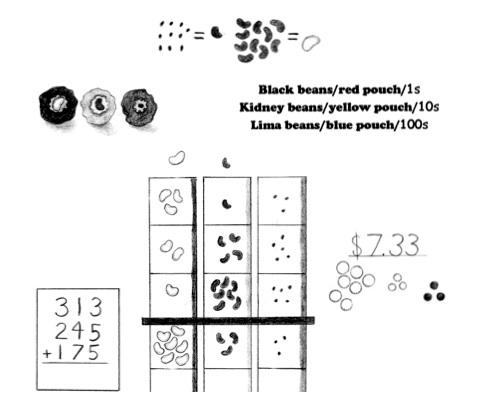
Tags:
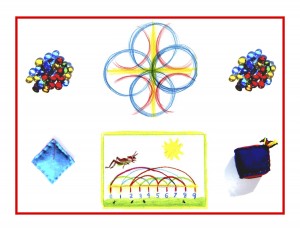
Day 135
For one year, 365 days, this blog will address the Common Core Standards from the perspective of creating an alternate, ambient learning environment for math. Ambient is defined as “existing or present on all sides, an all-encompassing atmosphere.” And ambient music is defined as: “Quiet and relaxing with melodies that repeat many times.
Why ambient? A math teaching style that’s whole and all encompassing, with themes that repeat many times through the years, is most likely to be effective and successful. Today’s post will feature the next Grade 2 Common Core Math Standard listed in blue, followed by its ambient counterpart as practiced by Waldorf Education and Math By Hand.
Number and Operations in Base Ten 2.NBT
Understand place value.
4. Compare two three digit numbers, based on mean ints of the hundreds, tens, and ones digits. using >, =, and < symbols to record the results of comparisons.
This concept is introduced in the Math By Hand / Grade 1 / Daily Lesson Plans book, with a story, and illustration, and lots of practice. As always, the story and the picture carry the day, taking the edge off the abstract concept. Having a picture in mind when attempting to recall and practice “greater-less than” is extremely helpful. The story below is told on day 1, retold on day 2 by the child(ren), illustrated, and then practiced. Here are the story, the instructions for teaching the concept, and the illustration, all from the MBH Grade 1 Daily Lesson Plans book. This should be brought back in Grade 2, then expanded to include two- and three-digit numbers.
Knowledge ensues in an environment dedicated to imaginative, creative knowing, where student and teacher alike surrender to the ensuing of knowledge as a worthy goal. Tune in tomorrow for more Common Core, and its ambient, Waldorf/Math By Hand counterpart.
Equations / Equivalency Story
The numbers love to play, alone and in teams. Often their games are tied, with both sides scoring the same. The equals sign is a good score keeper who sees both sides. (Hold your hands in front, palms down facing different directions, with index fingers slightly pointed.) The numbers also like to compete one on one, to show whose value is greater or less. Then they use a special sign, one that cheers the greater number, turning away from the number that’s less. (A “talking” gesture with your fingertips shows the “greater-less than” sign.)
Greater-Less Than Story / Retelling / Activity / Drawing
Have the child(ren) retell the story. Compare the “talking fingers” gesture to the greater-less than sign, saying the open end cheers for the greater number and the closed end turns away from the smaller number.
Do a guided drawing page of several examples. Write the equations and captions in green, surrounding GREATER and the greater number with a yellow background and rays, and LESS and the lesser number with blue.
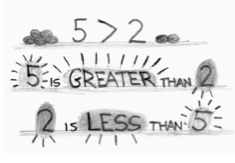
Tags:
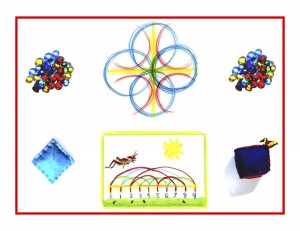
Day 134
For one year, 365 days, this blog will address the Common Core Standards from the perspective of creating an alternate, ambient learning environment for math. Ambient is defined as “existing or present on all sides, an all-encompassing atmosphere.” And ambient music is defined as: “Quiet and relaxing with melodies that repeat many times.
Why ambient? A math teaching style that’s whole and all encompassing, with themes that repeat many times through the years, is most likely to be effective and successful. Today’s post will feature the next Grade 2 Common Core Math Standard listed in blue, followed by its ambient counterpart as practiced by Waldorf Education and Math By Hand.
Number and Operations in Base Ten 2.NBT
Understand place value.
3. Read and write numbers up to 1,000 using base-ten numerals, number names, and expanded form.
Before beginning today’s post, just a thought. With all the attention being given Common Core, and the very significant amount of parent and teacher objection to its developmental inappropriateness and challenging to downright ridiculous curriculum applications and testing, and the real, severe harm caused children by CCSS, why am I doing this? Well, it is entirely possible that Common Core will be scrapped, or reformed, or sidestepped.
But then again, it could be here to stay, the way other senseless things seem to be. (I started to list them, but it’s too depressing and the list is way too long. You get the idea.) Sooooo, if it’s here to stay and we have to somehow deal with it, then this blog is of interest and is a valuable resource. On the other hand, it’s also an opportunity to expand/expound on the Waldorf-Math By Hand system in a specific, directed way. I have, and will continue to, been/be vigilant and crystal clear about what and when CCSS is missing the mark.
Base-ten numerals up to 1,000 are liberally used throughout all calculations with the 4 processes. Math By Hand strongly advises that answers should be written out in words as well as numbers. This also allows a sense of their expanded form as the numbers are put into words, for example: 743 is written as seven hundred and forty three. Direct exercises with expanded form are also included such as: 7 hundreds, 4 tens, and 3 ones. See below for a page from the Grade 2 Math By Hand binder.
Knowledge ensues in an environment dedicated to imaginative, creative knowing, where student and teacher alike surrender to the ensuing of knowledge as a worthy goal. Tune in tomorrow for more Common Core, and its ambient, Waldorf/Math By Hand counterpart.
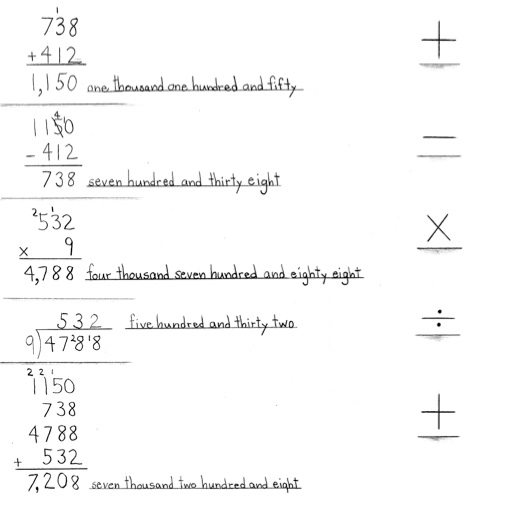
Tags:
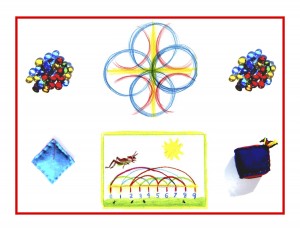
Day 133
For one year, 365 days, this blog will address the Common Core Standards from the perspective of creating an alternate, ambient learning environment for math. Ambient is defined as “existing or present on all sides, an all-encompassing atmosphere.” And ambient music is defined as: “Quiet and relaxing with melodies that repeat many times.
Why ambient? A math teaching style that’s whole and all encompassing, with themes that repeat many times through the years, is most likely to be effective and successful. Here is the promised times tables movement/lesson/drawing for yesterday’s fable, The Ant and the Grasshopper. Please see the illustration above and read the instructions below.
The 3’s and 7’s are the only tables whose patterns touch all the numbers from 0-9. This is illustrated by the “jumps” the Grasshopper makes, hopping back and forth until he covers all 10 numbers. The tie-in with the story is that the Grasshopper’s playfulness and long legs enable him to make all of the intricate back and forth jumps, while the plodding Ant can only watch in amazement. This is a bit of a twist on the moral and intent of the story, perhaps bringing in the value and joy of playfulness alongside the virtues of thrift and hard work. The story, picture, and physical imprint are all invaluable learning aids!
Use a crayon to write the numbers 0-9, large, one each on ten large, unlined index cards. Place them 6-8 inches apart, lined up, on the floor. Using the movement shown, have the child(ren) jump the numbers (the cards represent the second digit for 2-digit numbers). They can physically jump as the Grasshopper, or toss a beanbag to each number. Start both the 3’s and 7’s at the 0. For the 3’s, it’s short jumps forward and long jumps back. The 7’s are long jumps forward and short jumps back, and both begin and end at the 0. Relay the Grasshopper’s agility consistently, throughout. Choose different colors for the sets of long and short jumps, as in the drawing up top. Use one color for the numbers, spaced evenly.
Knowledge ensues in an environment dedicated to imaginative, creative knowing, where student and teacher alike surrender to the ensuing of knowledge as a worthy goal. Tune in tomorrow for more Common Core, and its ambient, Waldorf/Math By Hand counterpart.
Tags:
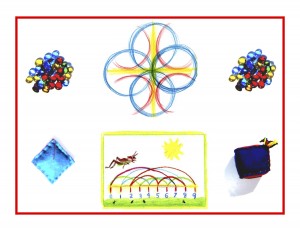
Day 132
For one year, 365 days, this blog will address the Common Core Standards from the perspective of creating an alternate, ambient learning environment for math. Ambient is defined as “existing or present on all sides, an all-encompassing atmosphere.” And ambient music is defined as: “Quiet and relaxing with melodies that repeat many times.
Why ambient? A math teaching style that’s whole and all encompassing, with themes that repeat many times through the years, is most likely to be effective and successful. Today’s post is a prelude to tomorrow’s. Shorty blog tonight, due to a borderline flu/cold combined with a bit of self-doubt and marginal existential despair. Question: how to continue with the daily tasks at hand as if as if the rest of the world isn’t falling apart? Answer: from my very fave Spring Valley Waldorf Teacher Training professor, Norman Davidson. He said, “Do the next thing, and do it cheerfully.”
A cheerful story! Tomorrow’s activity, excerpted from Math By Hand, blends fables and times tables practice: an excellent pairing. It’s centered around the fable, The Ant and the Grasshopper, and here it is.
In a field one summer’s day a Grasshopper was hopping about, chirping and singing to its heart’s content. An Ant passed by, bearing along with great toil an ear of corn he was taking to the nest. “Why not come and chat with me,” said the Grasshopper, “instead of toiling and moiling in that way?” “I am helping to lay up food for the winter,” said the Ant, “and recommend you to do the same.” “Why bother about winter?” said the Grasshopper; “we have got plenty of food at present.” But the Ant went on its way and continued its toil. When the winter came the Grasshopper had no food and found itself dying of hunger, while it saw the ants distributing every day corn and grain from the stores they had collected in the summer.
Knowledge ensues in an environment dedicated to imaginative, creative knowing, where student and teacher alike surrender to the ensuing of knowledge as a worthy goal. Tune in tomorrow for the times tables that go with the story! See the picture above to guess which ones it might be . . .
Tags:
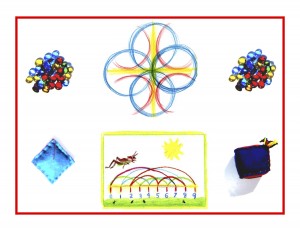
Day 131
For one year, 365 days, this blog will address the Common Core Standards from the perspective of creating an alternate, ambient learning environment for math. Ambient is defined as “existing or present on all sides, an all-encompassing atmosphere.” And ambient music is defined as: “Quiet and relaxing with melodies that repeat many times.
Why ambient? A math teaching style that’s whole and all encompassing, with themes that repeat many times through the years, is most likely to be effective and successful. Today’s post will feature the next Grade 2 Common Core Math Standard listed in blue, followed by its ambient counterpart as practiced by Waldorf Education and Math By Hand.
Number and Operations in Base Ten 2.NBT
Understand place value.
2. Count within 1,000; skip-count by 2’s, 5’s, 10’s, and 100’s.
Skip-counting by 2’s, 5’s, and 10’s began and continued throughout Grade 1, as a first introduction to those times tables. The rest of the times tables are introduced at the beginning of Grade 2, with some skip-counted like this:
3’s: alternate whisper/tip-toe with step/speak
1-2-3-4-5-6-7-8-9-10-11-12-13-14-15 . . .
4’s: alternate whisper/tip-toe with step/speak
2-4-6-8-10-12-14-16-18-20 . . .
Because the 6’s, 7’s, and 8’s are the most challenging times tables, Math By Hand uses a special hand-trick with oversized cotton gardening gloves as a learning aid. 9’s are learned through a pattern reinforced through movement and illustration. This pattern is the way the first and second digits of the table ascend and descend:
0-9
1-8
2-7
3-6
4-5
5-4
6-3
7-2
8-1
9-0
The 11’s are simply doubled numbers, and the 12’s are the endings of all the others. If the times tables can be approached in this way, step-by-step and consistently, day-by-day, they become so much more doable. Then confidence is gained while essential skills are learned.
Knowledge ensues in an environment dedicated to imaginative, creative knowing, where student and teacher alike surrender to the ensuing of knowledge as a worthy goal. Tune in tomorrow for more Common Core, and its ambient, Waldorf/Math By Hand counterpart.
Tags:
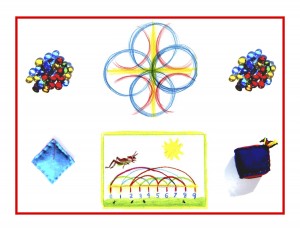
Day 130
For one year, 365 days, this blog will address the Common Core Standards from the perspective of creating an alternate, ambient learning environment for math. Ambient is defined as “existing or present on all sides, an all-encompassing atmosphere.” And ambient music is defined as: “Quiet and relaxing with melodies that repeat many times.
Why ambient? A math teaching style that’s whole and all encompassing, with themes that repeat many times through the years, is most likely to be effective and successful. Today’s post will feature the next Grade 2 Common Core Math Standard listed in blue, followed by its ambient counterpart as practiced by Waldorf Education and Math By Hand.
Number and Operations in Base Ten 2.NBT
Understand place value.
1. Understand that the three digits of a three-digit number represent amounts of hundreds, tens, and ones; e.g., 706 equals seven hundreds, zero tens, and six ones. Understand the following as special cases:
a) 100 can be thought of as a bundle of the tens — called a “hundred.”
b) The numbers 100, 200, 300, 400, 500, 600, 700, 800, 900 refer to one, two, three, four, five, six, seven, eight, or nine hundreds (and 0 tens and 0 ones).
Place value is taught at the start of the second math block so practice with the 4 processes can move on to the next level. This absolutely must be taught concretely, with lots of images and movement. Here’s a place value story. When I taught charter school homeschoolers, I visited students one-on-one every other week in their homes. One of my students, a second grade boy who could not get the concept of place value and regrouping, was also an electronic wizard. Ironically, he was able to engineer advanced electrical projects, like setting an alarm device under the front door welcome mat that would sound in his room whenever someone visited. Amazing! Yet, he was stumped by this math concept.
I lay four big felt columns on the floor: red, yellow, blue, and green, and told him that the red was the 1’s column, yellow the 10’x, green the 100’s, and blue the 1,000’s. After writing five sets of the numbers 0-9 on blank index cards, and very small cards numbered 1’s and 2’s, I set up a column of three three-digit numbers on a large piece of paper:
352
768
+234
I then instructed him to place the numbers on the correct columns and to begin adding up the 1’s column. (Any aids can be used for adding here: counting on fingers, stepping, jumping, etc.) When he reached the 1’s total, I asked him how he would show the answer. He put the 4 at the bottom and I handed him a small “1” card, telling him to jump to the top of the 10’s column with it. He jumped, and he got it, instantly!
Math By Hand uses this model, along with a smaller, tabletop version. In this version there are three columns, red, yellow, and blue, that are used with three kinds of beans in color coordinated pouches: black beans/red/1’s, kidney beans/yellow/10’s, lima beans/blue/100’s. The beans are used as counters and “cashed in” for the next higher beans when needed. Both of these activities make the concepts fully concrete and pictorial.
These concrete models work a lot better than either the circles and tally marks on paper or the unifix cubes that are used on Common Core worksheets. Confusion clears up instantly and magically when concepts are tied to stories, images, or objects! Remember that knowledge ensues in an environment dedicated to imaginative, creative knowing, where student and teacher alike surrender to the ensuing of knowledge as a worthy goal. Tune in tomorrow for more Common Core, along with its ambient, Waldorf/Math By Hand counterpart.
Tags:
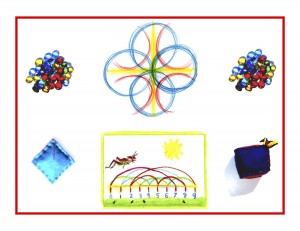
Day 129
For one year, 365 days, this blog will address the Common Core Standards from the perspective of creating an alternate, ambient learning environment for math. Ambient is defined as “existing or present on all sides, an all-encompassing atmosphere.” And ambient music is defined as: “Quiet and relaxing with melodies that repeat many times.
Why ambient? A math teaching style that’s whole and all encompassing, with themes that repeat many times through the years, is most likely to be effective and successful. Today’s post will feature the next Grade 2 Common Core Math Standard listed in blue, followed by its ambient counterpart as practiced by Waldorf Education and Math By Hand.
Operations and Algebraic Thinking 2.OA
Work with equal groups of objects to gain foundations for multiplication.
4. Use addition to find the total number of objects arranged in rectangular arrays with up to 5 rows and up to 5 columns; write an equation to express the total as a sum of equal addends.
This was covered repeatedly in Grade 1, and is reviewed at the beginning of Grade 2. It’s used most effectively when comparing addition and multiplication. This is another good reason why all 4 processes should be taught at once, from the beginning. If there’s no need to build a foundation for multiplication now in Grade 2, more advanced concepts in multiplication that are related to the above standard can be explored.
In the Waldorf and Math By Hand Grade 2 curriculum, fables are used to teach and practice math concepts. Fables lend themselves beautifully to this purpose. In order to elaborate fully on this relationship, I will devote tomorrow’s post to it. Pairing the following fable with the square numbers up to 25 is a concept that is somewhat related to the above standard. Having worked with the 5’s table since the beginning of Grade 1, it’s appropriate to now interpret this standard along these lines.
Here is a fable, followed by instructions and a drawing for applying it to the square numbers up to 25.
The Lion and the Mouse
A Lion lay asleep in the forest, his great head resting on his paws. A timid little Mouse came upon him unexpectedly, and in her fright and haste to get away, ran across the Lion’s nose. Roused from his nap, the Lion laid his huge paw angrily on the tiny creature to kill her.
“Spare me!” begged the poor Mouse. “Please let me go and some day I will surely repay you.”
The Lion was much amused to think that a Mouse could ever help him. But he was generous and finally let the Mouse go.
Some days later, while stalking his prey in the forest, the Lion was caught in the toils of a hunter’s net. Unable to free himself, he filled the forest with his angry roaring. The Mouse knew the voice and quickly found the Lion struggling in the net. Running to one of the great ropes that bound him, she gnawed it until it parted, and soon the Lion was free.
“You laughed when I said I would repay you,” said the Mouse. “Now you see that even a Mouse can help a Lion.”
A kindness is never wasted.
The Square Numbers Up to 5 / 25 and the Mouse
1) Lay out the pattern with dots first. These can be the knots in the net.
2) Add the lines between the dots to create the squares, erasing in spots and adding the gnawed places.
3) Write all the counting numbers in lightly, darkening the “X” numbers, with the square number on the bottom right. Write the equation next to each one.
4) Create one more 5 square with all the square numbers in different colors inside. Title the drawing and add our hero the Mouse!
Knowledge ensues in an environment dedicated to imaginative, creative knowing, where student and teacher alike surrender to the ensuing of knowledge as a worthy goal. Tune in tomorrow for more Common Core, along with its ambient, Waldorf/Math By Hand counterpart.
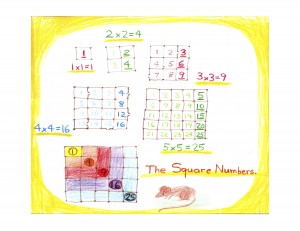
Tags:
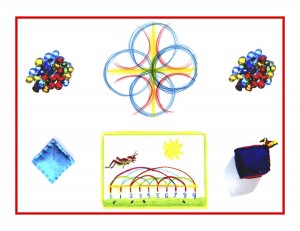
Day 128
For one year, 365 days, this blog will address the Common Core Standards from the perspective of creating an alternate, ambient learning environment for math. Ambient is defined as “existing or present on all sides, an all-encompassing atmosphere.” And ambient music is defined as: “Quiet and relaxing with melodies that repeat many times.
Why ambient? A math teaching style that’s whole and all encompassing, with themes that repeat many times through the years, is most likely to be effective and successful. Today’s post will feature an excellent article on the nature of Waldorf education and how it nourishes the heart of childhood.
Pictures Which Nourish the Soul, Why Waldorf Teachers Tell Parables
By Bernd Kettel, May 2014
Between the change of teeth and puberty, children imitate the pictures of the world which the teacher describes to them with the awakening powers of their imagination. If these pictures are spiritually vivid, they support the healthy development of their faculties.
Here’s the link to the article:
#mce_temp_url#
Knowledge ensues in an environment dedicated to imaginative, creative knowing, where student and teacher alike surrender to the ensuing of knowledge as a worthy goal. Tune in tomorrow for more Common Core, along with its ambient, Waldorf/Math By Hand counterpart.
Tags:

